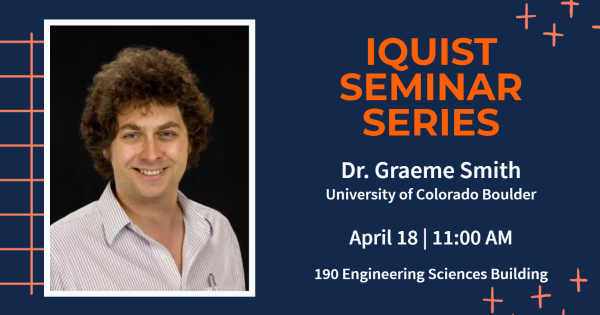
IQUIST Seminar: "The theory of quantum information: Channels, Capacities, and all that," Graeme Smith, University of Colorado Boulder
- Event Type
- Seminar/Symposium
- Sponsor
- IQUIST
- Location
- 190 Engineering Sciences Building, 1101 W Springfield Ave, Urbana, IL 61801
- Date
- Apr 18, 2023 11:00 - 11:50 am
- Speaker
- Graeme Smith, Associate Professor, Department of Physics, University of Colorado Boulder
- Contact
- Hannah Stites
- hstites2@illinois.edu
- Phone
- 217-300-4072
- Views
- 216
- Originating Calendar
- IQUIST Seminar Series
The Theory of Quantum Information: Channels, Capacities, and All That
Abstract: Information theory offers mathematically precise theory of communication and data storage that guided and fueled the information age. Initially, quantum effects were thought to be an annoying source of noise, but we have since learned that they offer new capabilities and vast opportunities. Quantum information theory seeks to identify, quantify, and ultimately harness these capabilities. A basic resource in this context is a noisy quantum communication channel, and a central goal is to figure out its capacities---what can you do with it? I’ll highlight the new and fundamentally quantum aspects that arise here, such as the role of entanglement, ways to quantify it, and bizarre new kinds of synergies between resources. These ideas elucidate the nature of communication in a quantum context, as well as revealing new facets of quantum theory itself.Bio: Graeme Smith received a B.Sc. in Physics from the University of Toronto in 2001, an MS and PhD in Physics from the California Institute of Technology in 2004 and 2006, respectively. He was a Research Associate in Computer Science at the University of Bristol 2006-2007, and a Postdoc at IBM Research 2007-2010. From 2010-2016 he was a Research Staff Member at IBM Research. Since 2016, he has been an Assistant then Associate Professor at the University of Colorado Boulder where he is also a JILA Fellow. Effective July 1, he will join the Institute for Quantum Computing at the University of Waterloo.